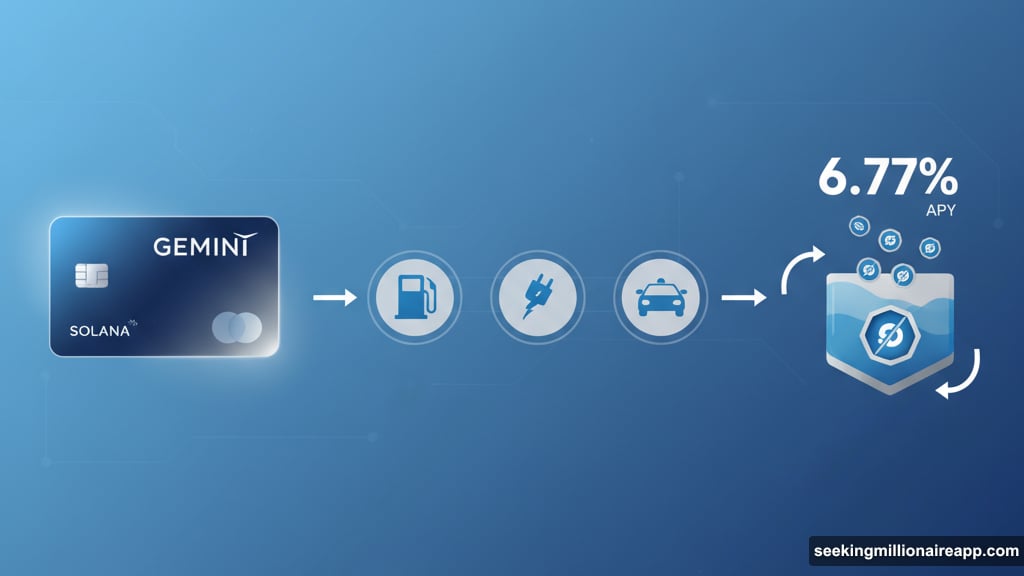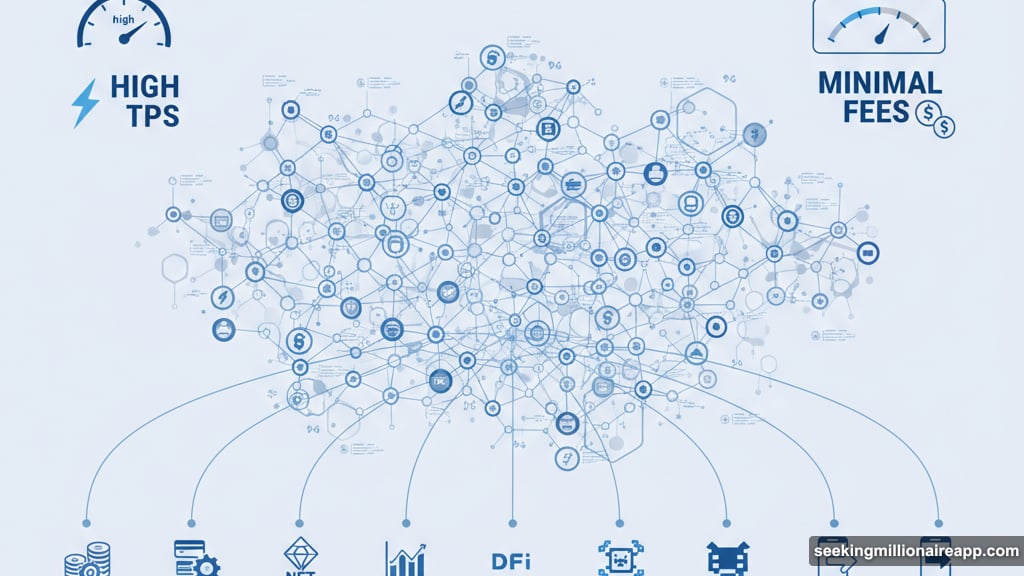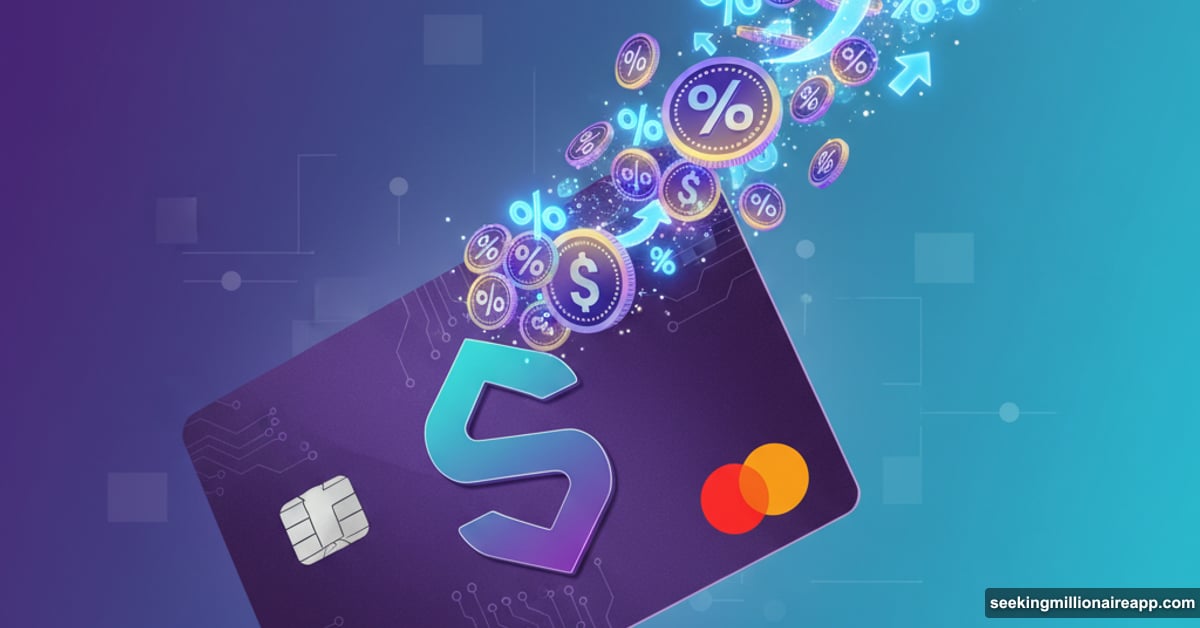The Winklevoss twins found a way to turn your gas station receipts into passive income. Their crypto exchange Gemini rolled out a Solana-branded credit card that automatically stakes your rewards.
This isn’t just another crypto cashback gimmick. The card combines spending rewards with DeFi yields in one package. So every dollar you spend could generate returns twice: once as cashback, then again through staking.
How the Auto-Staking Actually Works
The mechanics are straightforward. You swipe the card for everyday purchases. Gemini credits SOL tokens to your account. Then those tokens automatically stake on Gemini’s platform.
No manual steps, no claiming rewards, no transferring between wallets. The system handles everything behind the scenes.
Gemini currently offers staking yields up to 6.77% on SOL. That’s on top of the cashback you already earned. Plus, you maintain full control of your funds and can unstake anytime.
Here’s the reward structure:
- 4% back on gas, EV charging, and rideshare
- Up to 10% back with select partner merchants
- Standard rates on other purchases
Those numbers beat most traditional credit cards. But the real value comes from compounding your rewards through staking.
The Solana Bet Behind This Move
Gemini picked Solana deliberately. The blockchain processes transactions faster than most competitors and charges minimal fees. That makes it practical for frequent small purchases.

Moreover, Solana’s ecosystem keeps growing. The network hosts hundreds of DeFi protocols, NFT marketplaces, and payment apps. Gemini wants to tap into that active community.
The timing matters too. Gemini cited data showing SOL holders who kept rewards for a year saw gains near 300%. Past performance doesn’t guarantee future results. But it explains why Gemini thinks Solana appeals to cardholders.
This follows Gemini’s XRP credit card launch in August. They’re clearly testing demand across different crypto communities. Each blockchain has its own passionate user base.
Real Costs and Catches to Consider
The card carries no annual fee. Foreign transactions don’t cost extra either. That removes two common credit card pain points.
But read the fine print carefully. Credit cards make money somehow. Gemini likely earns interchange fees from merchants when you swipe. They share a portion as rewards.
Staking yields fluctuate based on network conditions. Today’s 6.77% could drop if more people stake or if Solana’s validator economics shift. Your actual returns may vary significantly.
Plus, you’re holding crypto rewards. If SOL’s price drops 20%, your effective cashback drops too. Traditional cashback cards pay dollars that don’t fluctuate. This creates price risk alongside the yield opportunity.
The card comes through Mastercard’s World Elite program. So you get typical perks like purchase protection and travel benefits. WebBank issues the actual card and handles credit underwriting.
Who Benefits Most From This Card
This makes sense for existing Solana believers. If you already plan to buy and stake SOL, turning spending into automatic accumulation works well.
Active spenders in bonus categories see the biggest advantage. Someone charging $500 monthly on gas at 4% back earns $20 in SOL. Staked at 6.77%, that generates about $1.35 more annually. Small amounts compound over time.
Crypto beginners should probably start simpler. Managing credit responsibly matters more than chasing yield. If you carry balances, interest charges will destroy any cashback gains instantly.

Remember that staking locks your funds temporarily. Gemini’s staking allows withdrawals, but there might be unstaking periods. Check those details before committing significant amounts.
The Broader Crypto Credit Card Trend
Gemini joins a growing field. Coinbase offers crypto rewards cards. BlockFi launched one before its bankruptcy. Traditional card companies are testing crypto features too.
Each card targets slightly different users. Some emphasize Bitcoin rewards. Others focus on stablecoins to avoid volatility. Gemini picked Solana to differentiate.
Competition should improve offerings over time. But it also fragments the market. Choosing the right card depends heavily on which crypto you want to accumulate and how you plan to use it.
The real innovation here is automatic staking. Most crypto cards require manual steps to put rewards to work. Gemini eliminated that friction. If the concept succeeds, expect competitors to copy it.
What This Means for Solana’s Adoption
Credit cards could drive meaningful adoption. People discover Solana by earning it on purchases. Some percentage will explore the ecosystem further. That creates organic growth.
The card also validates Solana’s positioning as a fast, cheap payment network. If Gemini didn’t think Solana could handle transaction volume efficiently, they wouldn’t have built around it.
But credit card adoption moves slowly. Even successful launches take years to reach scale. This won’t change Solana’s trajectory overnight. It’s one data point among many.
Gemini went public last month at $28 per share, valuing the company above $3 billion. That gives them resources to market aggressively. Whether they actually do remains to be seen.
The Math on Your Actual Returns
Let’s run realistic numbers. Say you spend $2,000 monthly across all categories. Assume average cashback of 2% (mixing bonus and regular categories).
That generates $40 in SOL monthly, or $480 yearly. Stake at 6.77% and you earn roughly $32 more from staking. Total value: $512 in year one.
Sounds decent. But factor in effort and risk. You’re managing crypto exposure, tracking tax implications, and accepting price volatility. Traditional 2% cashback cards deliver $480 risk-free.
The equation tilts positive if you already wanted SOL exposure anyway. Then the card becomes a convenient accumulation tool. It tilts negative if you’re chasing yield without understanding crypto fundamentals.
One more consideration: taxes. Crypto rewards likely trigger taxable events. Staking rewards definitely do. That complexity adds bookkeeping burden most people prefer to avoid.
My Take on Who Should Apply
This card makes sense for three groups. First, committed Solana users who would buy SOL regardless. You might as well earn it through spending.
Second, high spenders in bonus categories. Someone charging significant gas or rideshare expenses captures meaningful value from 4% rewards.
Third, people comfortable managing crypto holdings and tax complexity. If you already track cost basis and taxable events, adding this card changes little.
Everyone else should probably skip it. The mental overhead and price risk outweigh the marginal yield advantage. A simple 2% cashback card delivers similar value with zero drama.
But give Gemini credit for innovation. Auto-staking eliminates friction that prevented many people from earning yield on rewards. If this model proves popular, it could reshape how crypto credit cards work.
The Winklevoss twins are betting Solana’s community wants this product. Time will tell if they’re right.
